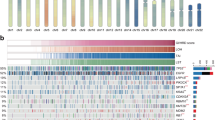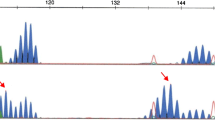Abstract
Objective: To analyse the microsatellite instability (MI) and loss of heterozygosity (LOH) in non-small cell lung cancer (NSCLC). Methods: MI and LOH at chromosome 17 were checked in 35 cases of NSCLC tumor-normal paired tissues using four microsatellite markers TP53 (17pl3.1), THRA1 (17qll.2–12), D17S579 (17ql2–21) and D17S855 (17q21) by PCR based analysis. Mutations of P53 exons 5–8 were also tested using PCR-single strand conformation polymorphism (PCR-SSCP) and PCR-denaturing gradient gel electrophoresis (PCR-DGGE) analysis. Results: 22 of 35 tumors (62.8%) displayed MI or LOH. 14 tumors (40.0%) exhibited MI, 11 tumors (31.4%) exhibited LOH, while 3 tumors (8.6%) exhibited MI and LOH concurrently. 23 tumors (65.7%) exhibited P53 gene mutations. The frequency of MI or LOH was obviously higher in the early-stage (stages I and II, 78.9%) than in the advanced-stage (stage III, 43.8%). However, the frequency of MI or LOH had no difference either between high-grade (75.0%) and low-grade (52.6%) differentiated NSCLC or between the tumors with P53 mutations (59.1%) and those without P53 mutations (69.2%). No relationship was observed between the presence of MI or LOH and the histologic subtype of NSCLC. Conclusion: The results suggest that MI and LOH at chromosome 17 may play a significant role in the development of NSCLC. The high frequency of MI or LOH in the early-stage tumors indicates that these genetic alterations could occur early during NSCLC development. Our data also show that the genetic alterations of microsatellite at chromosome 17 was not associated with P53 gene mutations.
Similar content being viewed by others
Reference
Froudarakis ME, Bouros D, Spandidos DA, et al. Microsatellite instability and loss of heterozygosity at chromosomes 17 in non-small cell lung cancer [J], Chest 1998; 113:1091.
Fong KM, Zimmerman PV, Smith PJ. Microsatellite instability and other molecular abnormalities in non-small cell lung cancer [J]. Cancer Res 1994; 54:2098.
Mountain CF. A new international staging system for lung cancer [J]. Chest 1986; 89(suppl):225.
Shridhar V, Siegfried J, Hunt J, et al. Genetic instability of microsatellite sequences in many non-small cell lung carcinomas [J]. Cancer Res 1994; 54:2084.
Loeb LA. Microsatellite instability: Marker of a mutator phenotype in cancer [J]. Cancer Res 1994; 54:5059.
Sanchez CM, Monzo M, Rosell R, et al. Detection of chromosome 3p alterations in serum DNA of non-small cell lung cancer patients [J]. Ann Oncol 1989; 113.
Author information
Authors and Affiliations
Corresponding author
Additional information
Foundation item: This work was supported by the Research Foundation from the Ministry of Public Health of China (No. 94-1-316).
Biography: GUO Xue-jun (1964-), associate professor, Department of Respiratory Medicine, Ruijin Hospital, Shanghai Second Medical University, majors in lung cancer and genetics of asthma.
Rights and permissions
About this article
Cite this article
Guo, Xj., Ni, Ph., Li, L. et al. Genetic alterrations of microsatellite markers at chromosome 17 in non-small cell lung cancer. Chin J Cancer Res 13, 181–184 (2001). https://doi.org/10.1007/BF02983881
Received:
Accepted:
Issue Date:
DOI: https://doi.org/10.1007/BF02983881




